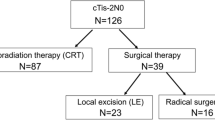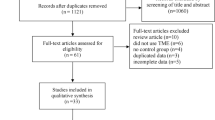Abstract
Purpose
The JCOG (Japan Clinical Oncology Group) 0212 study did not confirm the noninferiority of mesorectal excision (ME) alone to ME with LLND for rectal or anal adenocarcinomas. Furthermore, the significance of LLND for SCCs remains unknown. We evaluated the significance of lateral lymph node dissection (LLND) of squamous cell carcinoma (SCC) of the anal canal.
Methods
This retrospective cohort study was conducted in 435 patients with SCCs among 1,781 patients with anal canal tumors. In 40 patients who underwent LLND, the 5-year relapse-free survival (5y-RFS) and 5-year overall survival (5y-OS) were compared between groups with positive and negative histopathological findings. In 71 patients with negative lateral lymph node metastasis in the preoperative diagnosis, the 5y-RFS, 5y-OS, and 5-year local recurrence-free survival were compared between patients who did and did not undergo LLND.
Results
The clinical and pathological T stages predicted pathological lateral pelvic lymph node metastasis. There was no statistically significant difference in 5y-RFS and 5y-OS between patients who did and did not undergo LLND. Among patients who underwent LLND, 5y-RFS in those with positive histopathological findings (15.0%) was worse than that in those without (59.2%) (p = 0.002).
Conclusions
In patients who underwent LLND, 5y-RFS in those with positive histopathological findings than in those without LLND did not contribute to prognosis.






Similar content being viewed by others

Data availability
No datasets were generated or analysed during the current study.
References
Fujita S, Mizusawa J, Kanemitsu Y et al (2017) Mesorectal excision with or without lateral lymph node dissection for clinical stage II/III lower rectal cancer (JCOG0212): a multicenter, randomized controlled, noninferiority trial. Ann Surg 266:201–207
Kumar V, Bansal S, Badola A et al (2022) Definitive chemoradiation in nonmetastatic squamous cell carcinoma anal canal: a single-institution experience. J Cancer Res Ther 18(Supplement):S405–S409
Yamada K, Saiki Y, Komori K et al (2022) Characteristics of anal canal cancer in Japan. Cancer Med 11:2735–2743
York: teN. UICC TNM classification of malignant tumors. 2017
Bekki T, Takakura Y, Kochi M et al (2019) Case report of hepatic pseudocyst: a rare manifestation of liver metastasis from an anal squamous cell carcinoma. Int J Surg Case Rep 62:77–84
Mitsuura C, Miyamoto Y, Ogawa K et al (2022) Successful management of anal squamous cell carcinoma with liver and ovary metastases: a case report. In Vivo 36:3023–3028
Benson AB 3rd, Arnoletti JP, Bekaii-Saab T et al (2012) Anal carcinoma, version 2.2012: featured updates to the NCCN guidelines. J Natl Compr Canc Netw. 10:449–54
Murofushi KN, Itasaka S, Shimokawa M et al (2023) A phase II study of concurrent chemoradiotherapy with 5-fluorouracil and mitomycin-C for squamous cell carcinoma of the anal canal (the JROSG 10–2 trial). J Radiat Res 64:154–161
Portale G, Parotto M, Pozza A, Scarpa M, Cavallin F (2022) Chemoradiation vs. local excision in the management of early squamous cell carcinoma of the anus: a systematic review. Int J Colorectal Dis. 37:1937–44
Rao S, Anandappa G, Capdevila J et al (2022) A phase II study of retifanlimab (INCMGA00012) in patients with squamous carcinoma of the anal canal who have progressed following platinum-based chemotherapy (POD1UM-202). ESMO Open 7:100529
Lustosa IKF, Camandaroba MPG, Mattos BRS, Silva SF, Iseas S, Riechelmann RP (2022) Cure rates according to dose-intensity of chemoradiation in T2N0 squamous cell carcinoma of the anal canal. Clin Colorectal Cancer 21:e226–e231
Mohamed AA, Schlenter M, Heinzel A, Kintsler S, Eble MJ (2022) Intensity-modulated radiotherapy associated with improved survival outcome in anal cancer. Front Oncol 12:911925
Bartelink H, Roelofsen F, Eschwege F et al (1997) Concomitant radiotherapy and chemotherapy is superior to radiotherapy alone in the treatment of locally advanced anal cancer: results of a phase III randomized trial of the European Organization for Research and Treatment of Cancer Radiotherapy and Gastrointestinal Cooperative Groups. J Clin Oncol 15:2040–2049
Chino J, Annunziata CM, Beriwal S et al (2020) Radiation therapy for cervical cancer: executive summary of an ASTRO clinical practice guideline. Pract Radiat Oncol 10:220–234
Acknowledgements
The authors thank participating 47 institutions (the Japanese Society for Cancer of the Colon and Rectum) as follows.
Coloproctology Center Takano Hospital, Aichi Cancer Center Hospital, Shizuoka Cancer Center Hospital, Cancer Institute Hospital of the Japanese Foundation for Cancer Research, National Cancer Center Hospital East, Kyoto University Hospital, Tokai University School of Medicine, Kanagawa Cancer Center, The University of Tokyo, National Cancer Center Hospital, National Defense Medical College, University of Ryukyus, Fujita Health University Hospital, Kindai University Faculty of Medicine, Kurume University School of Medicine, Tokyo Metropolitan Cancer and Infectious Diseases Center Komagome Hospital, Osaka University, Osaka Police Hospital, Kochi Health Sciences Center, Japanese Red Cross Medical Center, Kyorin University Faculty of Medicine, Showa University Northern Yokohama Hospital, School of Medicine, University of Occupational and Environmental Health, Tohoku University Graduate School of Medicine, Toho University Omori Medical Center, and Yokohama City University Medical Center
Author information
Authors and Affiliations
Contributions
Koji Komori: Conceptualization; methodology; data curation; investigation; validation; formal analysis; supervision; writing –original draft; visualization; project administration; resources. Kazutaka Yamada: Conceptualization. Yoichi Ajioka: Conceptualization. Kenichi Sugihara: Conceptualization.
Corresponding author
Ethics declarations
Competing interests
The authors declare no competing interests.
Additional information
Publisher's Note
Springer Nature remains neutral with regard to jurisdictional claims in published maps and institutional affiliations.
Rights and permissions
Springer Nature or its licensor (e.g. a society or other partner) holds exclusive rights to this article under a publishing agreement with the author(s) or other rightsholder(s); author self-archiving of the accepted manuscript version of this article is solely governed by the terms of such publishing agreement and applicable law.
About this article
Cite this article
Komori, K., Yamada, K., Ajioka, Y. et al. Significance of lateral lymph node dissection in squamous cell carcinoma of the anal canal: a retrospective cohort study. Langenbecks Arch Surg 409, 157 (2024). https://doi.org/10.1007/s00423-024-03349-1
Received:
Accepted:
Published:
DOI: https://doi.org/10.1007/s00423-024-03349-1



